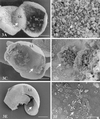Echinococcus multilocularis alkaline phosphatase as a marker for metacestode damage induced by in vitro drug treatment with albendazole sulfoxide and albendazole sulfone
- PMID: 11451682
- PMCID: PMC90639
- DOI: 10.1128/AAC.45.8.2256-2262.2001
Echinococcus multilocularis alkaline phosphatase as a marker for metacestode damage induced by in vitro drug treatment with albendazole sulfoxide and albendazole sulfone
Abstract
Alveolar echinococcosis (AE) is caused by the metacestode stage of the fox tapeworm Echinococcus multilocularis. The disease affects the human liver and occasionally other organs and is fatal if treatment is unsuccessful. The present chemotherapy of AE is based on the administration of benzimidazole carbamate derivatives, such as mebendazole and albendazole. Albendazole treatment has been found to be ineffective in some cases, parasitostatic rather than parasiticidal, and the recurrence rate is rather high. Therefore, chemotherapy usually involves the lifelong uptake of massive doses of albendazole and new treatment options are urgently needed. In order to avoid costly and time-consuming animal experimentation, a first step in searching for novel parasiticidal compounds could be the in vitro drug screening of novel compounds by employing metacestode cultivation. However, presently used techniques (e.g., transmission electron microscopy) for determination of parasite viability involve costly equipment and time-consuming preparation of rather large amounts of parasite material. We therefore searched for a parasite marker which can be easily traced and the presence or absence of which is indicative of parasite viability. In this study we show that the increase of E. multilocularis alkaline phosphatase activity in culture supernatants during in vitro drug treatment with albendazole derivatives correlates with the progressive degeneration and destruction of the metacestode tissue. The inexpensive and rapid assay presented here will serve as an ideal tool for performing first-round in vitro tests on the efficacy of a large number of antiparasitic compounds.
Figures




Similar articles
-
Efficacies of albendazole sulfoxide and albendazole sulfone against In vitro-cultivated Echinococcus multilocularis metacestodes.Antimicrob Agents Chemother. 1999 May;43(5):1052-61. doi: 10.1128/AAC.43.5.1052. Antimicrob Agents Chemother. 1999. PMID: 10223913 Free PMC article.
-
Application of an in vitro drug screening assay based on the release of phosphoglucose isomerase to determine the structure-activity relationship of thiazolides against Echinococcus multilocularis metacestodes.J Antimicrob Chemother. 2010 Mar;65(3):512-9. doi: 10.1093/jac/dkp490. Epub 2010 Jan 19. J Antimicrob Chemother. 2010. PMID: 20085998
-
Activities of fenbendazole in comparison with albendazole against Echinococcus multilocularis metacestodes in vitro and in a murine infection model.Int J Antimicrob Agents. 2014 Apr;43(4):335-42. doi: 10.1016/j.ijantimicag.2014.01.013. Epub 2014 Feb 12. Int J Antimicrob Agents. 2014. PMID: 24646943
-
Innovative chemotherapeutical treatment options for alveolar and cystic echinococcosis.Parasitology. 2007 Nov;134(Pt 12):1657-70. doi: 10.1017/S0031182007003198. Epub 2007 Jul 16. Parasitology. 2007. PMID: 17631693 Review.
-
Alveolar and cystic echinococcosis: towards novel chemotherapeutical treatment options.J Helminthol. 2009 Jun;83(2):99-111. doi: 10.1017/S0022149X0928936X. Epub 2009 Mar 19. J Helminthol. 2009. PMID: 19296876 Review.
Cited by
-
In vitro and in vivo effects of 3-bromopyruvate against Echinococcus metacestodes.Vet Res. 2019 Nov 19;50(1):96. doi: 10.1186/s13567-019-0710-7. Vet Res. 2019. PMID: 31744550 Free PMC article.
-
In vitro metacestodicidal activities of genistein and other isoflavones against Echinococcus multilocularis and Echinococcus granulosus.Antimicrob Agents Chemother. 2006 Nov;50(11):3770-8. doi: 10.1128/AAC.00578-06. Epub 2006 Sep 5. Antimicrob Agents Chemother. 2006. PMID: 16954323 Free PMC article.
-
In vitro effects of lonidamine and 6-aminonicotinamide against Echinococcus granulosussensu stricto and Echinococcus multilocularis.Vet Res. 2020 Feb 26;51(1):29. doi: 10.1186/s13567-020-00744-6. Vet Res. 2020. PMID: 32101153 Free PMC article.
-
Genome-wide analysis of excretory/secretory proteins in Echinococcus multilocularis: insights into functional characteristics of the tapeworm secretome.Parasit Vectors. 2015 Dec 30;8:666. doi: 10.1186/s13071-015-1282-7. Parasit Vectors. 2015. PMID: 26715441 Free PMC article.
-
Secretion into Milk of the Main Metabolites of the Anthelmintic Albendazole Is Mediated by the ABCG2/BCRP Transporter.Antimicrob Agents Chemother. 2022 Jul 19;66(7):e0006222. doi: 10.1128/aac.00062-22. Epub 2022 Jun 23. Antimicrob Agents Chemother. 2022. PMID: 35736132 Free PMC article.
References
-
- Ammann R W. Improvement of liver resectional therapy by adjuvant chemotherapy in alveolar hydatid disease. Swiss Echinococcosis Study Group (SESG) Parasitol Res. 1991;77:290–293. - PubMed
-
- Ammann R W, Illitsch N, Marincek B, Freiburghaus A U. Effect of chemotherapy on the larval mass and the long-term course of alveolar echinococcosis. Hepatology. 1994;19:735–742. - PubMed
-
- Ammann R W, Hoffmann A F, Eckert J. Swiss study of chemotherapy of alveolar echinococcosis—review of a 20-year clinical research project. Schweiz Med Wochenschr. 1999;129:323–332. - PubMed
-
- Ammann R W, Hirsbrunner R, Cotting J, Steiger U, Jacquier P, Eckert J. Recurrence rate after discontinuation of long-term mebendazole therapy in alveolar echinococcosis (preliminary results) Am J Trop Med Hyg. 1990;43:506–515. - PubMed
-
- Arme C, Pappas P W, editors. The biology of the Eucestoda. Vol. 2. London, England: Academic Press; 1983. Host-parasite interface; pp. 297–310.
Publication types
MeSH terms
Substances
LinkOut - more resources
Full Text Sources

